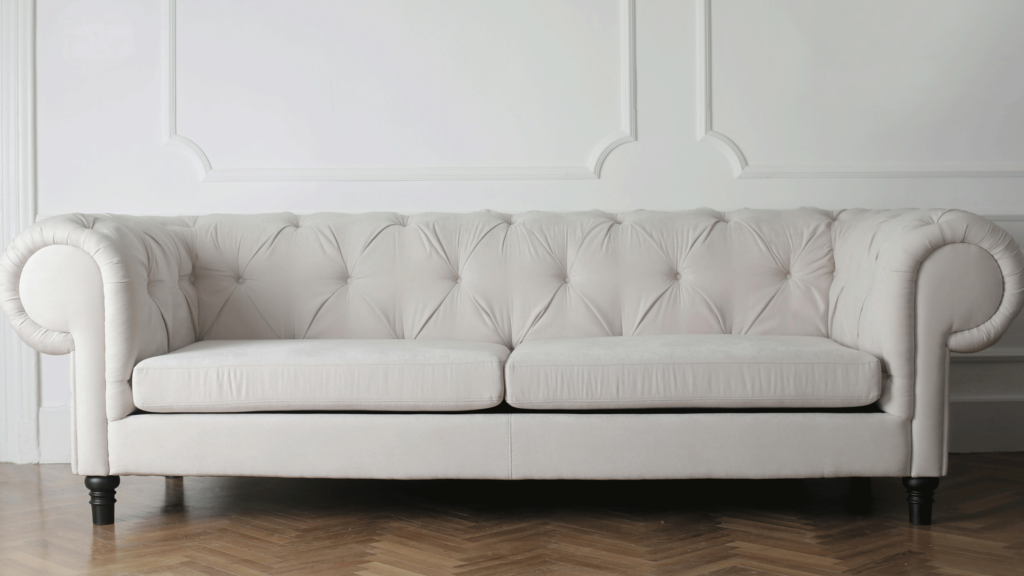“], “filter”: { “nextExceptions”: “img, blockquote, div”, “nextContainsExceptions”: “img, blockquote, a.btn, a.o-button”} }”>
Heading out the door? Read this article on the new Outside+ app available now on iOS devices for members!
>”,”name”:”in-content-cta”,”type”:”link”}}”>Download the app.
Maybe you’ve had a challenging day and don’t have the energy to roll out your yoga mat. Or maybe you understand the benefit of chair yoga but find it to be so much more convenient and comfortable to not move from the couch. The following couch yoga practice combines the accessibility of chair yoga with the benefits of seated and reclined yoga poses.
Your practice starts with some seated poses that warm up your major joints and move your spine. Then it transitions to lying down for some more restorative stretches. And at the end, you get to prop yourself for a really comfy couch yoga version of Savasana and remain there as long as you desire or your day allows, ensuring you experience the rest and restoration you deserve.
A 30-Minute Couch Yoga Practice
Before you begin your couch yoga practice, make yourself comfortable. Sometimes couches lack firmness, so check if you have enough support. You may need to add something beneath you to make it firmer. I’m sitting on a folded yoga mat or you can try a folded blanket or a large cushion. You want your hips and knees to be about the same height from the floor. If your legs are shorter, you can put something under your feet instead.
As with any physical practice of yoga, don’t force the pose in couch yoga. You want to adapt your practice to serve you. Find that edge where you’re getting a gentle stretch without any strain. It’s okay for a little work, but we don’t want it to cause pain. Another way to check if you’re straining is if you’re holding your breath. Make sure your breath is moving all the time.
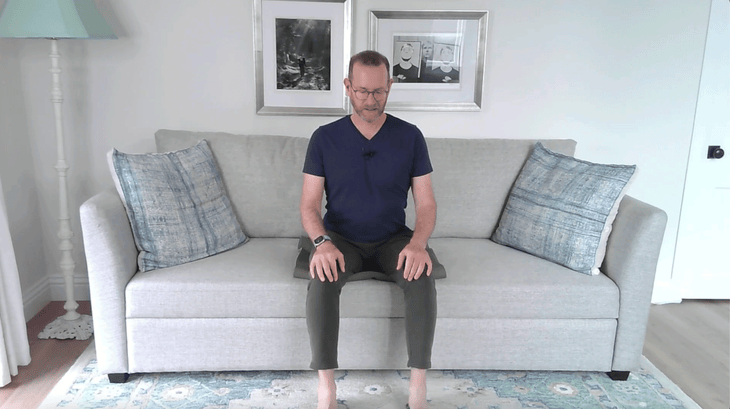
Seated Breathwork
Start by checking your posture. See if you can lengthen your spine and sit up nice and tall. If you have trouble sitting up with your own strength, you can place some pillows behind you, especially around your lower back, for support.
Take a few breaths. As you exhale, see if you can feel that you’re grounded down into the Earth. As you inhale, feel yourself lift away from the Earth, away from gravity, up into the sky. You can have your eyes open or closed, whichever you prefer. Take a few breaths with that feeling of the exhalation grounding you down into the Earth, and the inhalation lifting you up into that open sky.
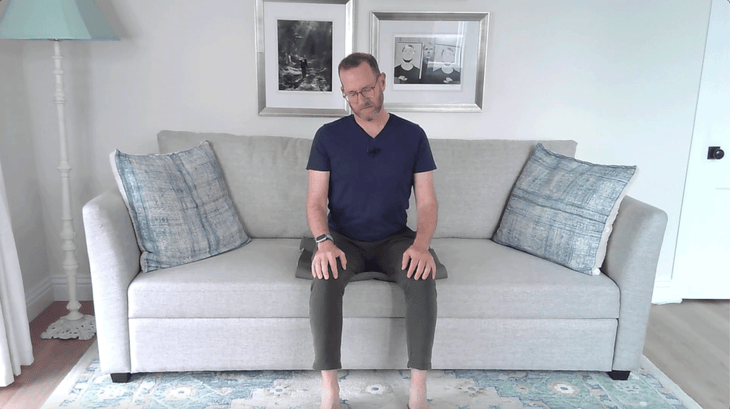
Seated Neck Stretches
You may want to tuck your chin slightly first. Inhale, lengthen your spine, lengthen your neck, and then exhale and bring your right ear toward your right shoulder. Notice how it feels to have your chin tucked slightly as you bend to the side, if you like.
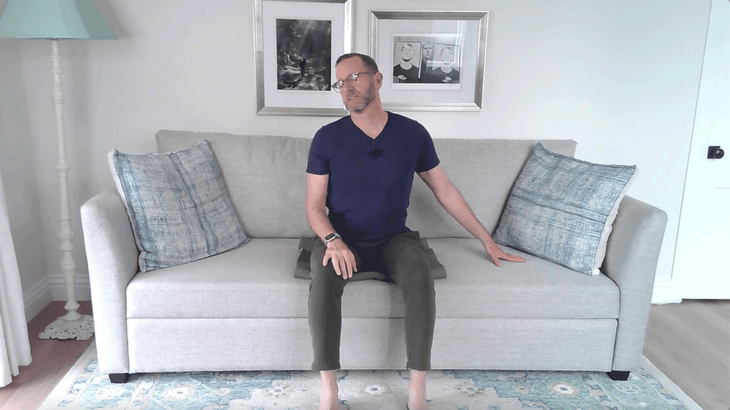
Remain here or you can take your left hand and reach down to the couch and slide it away to create a little more space between your left ear and left shoulder. You could also lift your chin slightly and see how that feels. Take a breath there and then exhale and relax.
Bring your head back to center, tuck your chin slightly, and lengthen the back of your neck. Inhale and then exhale as you bring your left ear toward your left shoulder. Reach your right hand toward the couch and slide it away from you. Lift your chin a little, creating length and space along the right side of your neck. Take a breath here and release.
Bring your head back to center. Inhale as you squeeze your shoulders toward your ears and exhale with a loud sigh as you release your shoulders. Let’s do that 2 more times. So inhale, squeeze the shoulders up, exhale, let go. Inhale, squeeze, exhale, release.
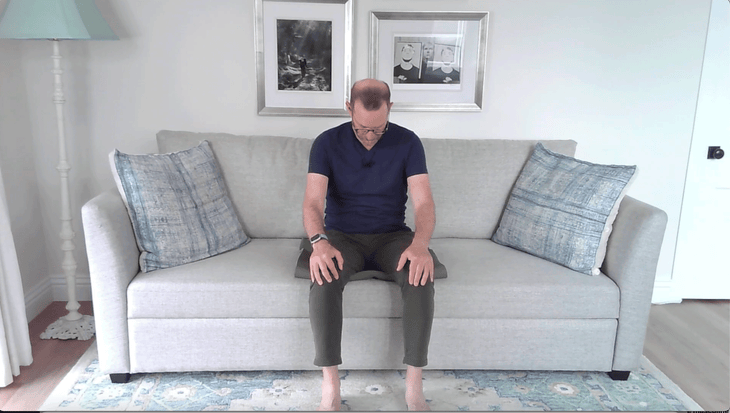
Seated Cat-Cow
We’ll start small with our Cat–Cow. I actually call this Kitten-Calf. Especially if you have osteoporosis in your spine, you want to be careful that any forward bending movements, if you do them at all, are subtle. Make it a micro movement that rounds your back just a little and lowers your head slightly. This is Kitten. Then move your belly forward a little, and your chin and chest lift as you inhale here in Calf. Then exhale back to Kitten.
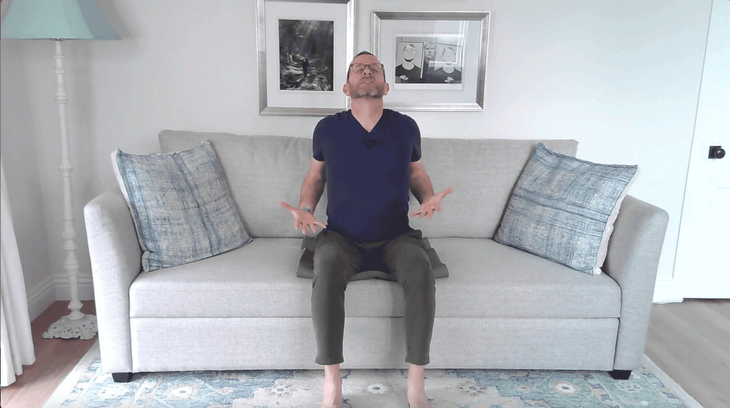
If you want, you can make your movements bigger. Perhaps in Cow you bring your elbows back behind you and turn your palms up.
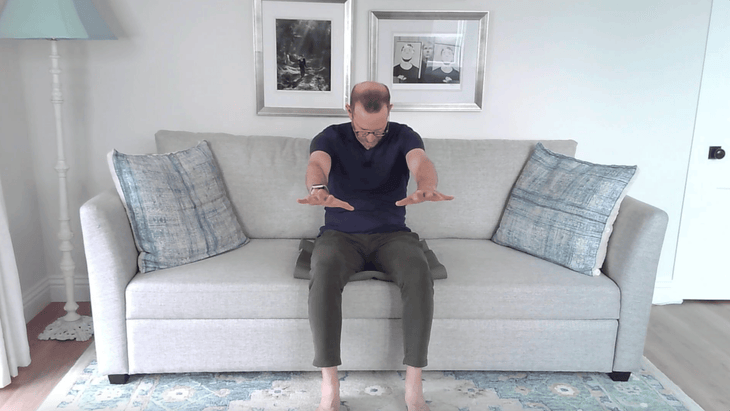
As you exhale to Cat, you could reach your arms in front of you to stretch the back of your shoulders. See how that feels. Inhale Cow with your elbows back and palms up. Exhale Cat as you round your back and reach in front of you. One more like that.
Come back to neutral. Notice how your spine feels.
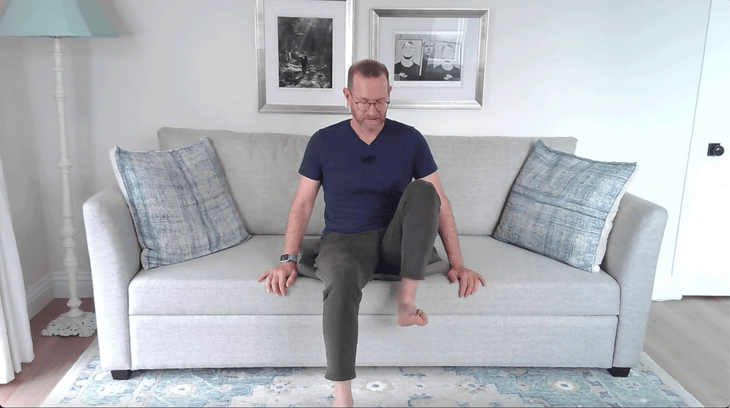
Seated Marching
Let’s do some marching in place. Sit slightly forward on the couch, and then bring awareness to your core muscles. Lift one leg at a time toward your chest and then lower it down. If that feels uncomfortable, you can use your hands to help without marching. Maybe coordinating with your breath. Inhale up, exhale down, inhale up, exhale, down, inhale, up, exhale, down.
This is helpful for strengthening the hip flexors and some of the deeper core muscles, including your psoas, which connects your inner thigh to your lower back.
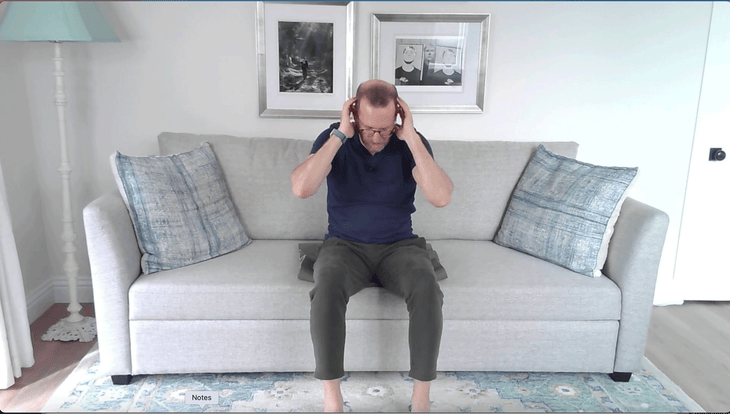
Seated Crunch
Let’s try another core strengthening. This is a seated crunch, which is less strenuous than those you might do lying on your back. If it’s comfortable, place your hands behind your head so they’re barely touching you. Then exhale as you engage your abdominal muscles as you would in a crunch and gently round your back and keep your neck long. Inhale, lift and lengthen. Exhale, crunch. If you can, on your next inhale, bring your elbows apart. And then exhale and bring your elbows slightly together. Inhale, elbows apart. Exhale, crunch with elbows coming together. One last time. Inhale, open, exhale, crunch, engage those abdominal muscles and then release. Take a moment to notice how you’re feeling.
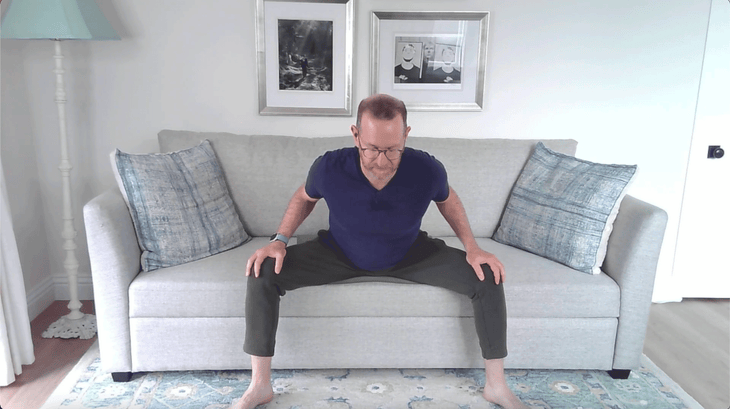
Seated Forward Bend
I like to practice side bends by taking my legs wide apart. So take a wide-legged stance. If it’s comfortable, inhale, lengthen your spine, and hinge forward to get a little more stretch. Notice how that feels. Take a breath there and then slowly come back up.
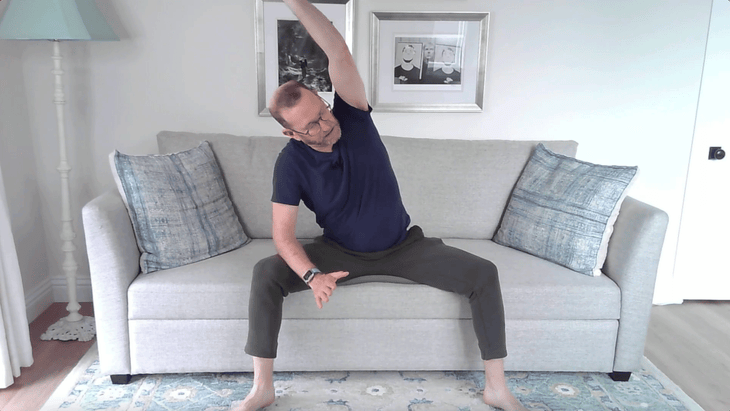
Seated Side Bend
Now turn your torso to the left. Inhale and lengthen your spine and then exhale and lean to your right as you take your right forearm onto your right thigh and bring your left hand either to your shoulder or overhead, lengthening along the left side of your body like in Extended Side Angle.
Lean your left shoulder back slightly, opening the front of the body a little more and maybe even looking upward. See how that feels. Take another breath here.
Slowly sit up and come back to center and then turn your torso to the right and repeat on his side by exhaling as you lean to the left with your left forearm on your left thigh, right hand on your right shoulder or reach your arm overhead.
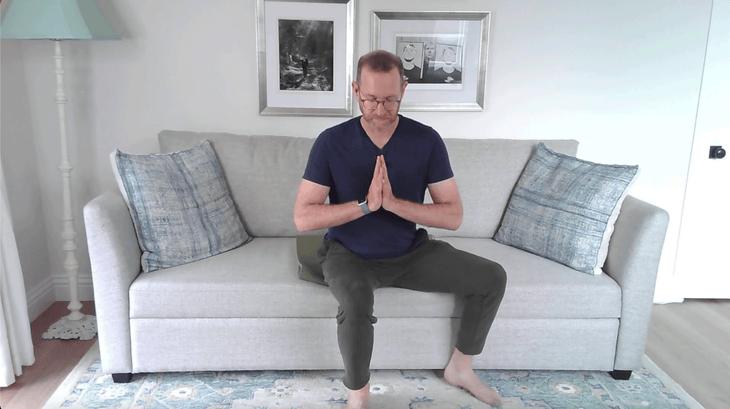
Seated Tree Pose
Bring your legs together for a seated balancing pose. Sit forward again on the couch and bring your right leg directly in front of you. Then open your left leg to the side, coming into your left toes if you want, and lean forward and really press the weight of your body into your front leg. Be careful that you’re not going to fall forward. You could even have a chair here in front of you, or a coffee table, if that helps you feel safer.
Engage all the muscles as you do in a Tree Pose and bring your palms together at your chest. Focus your eyes on a spot right in front of you. And then, if you like, raise your arms overhead or extend them out in a Y shape. Keep your gaze, or drishti, on that spot. The idea is to work on balance in this pose. But, since we’re seated, we need to add an additional balancing challenge. Imagine a wind coming into the branches of your tree and you’re going to sway with that wind. Be sure you’re not going to lose your balance. You can even move forward and back a little. Notice how staring at one spot with your eyes really helps you stay balanced and not fall over. Keep your breath relaxed.
Then switch sides so your left foot is directly in front of you, close in, and your right leg is open to the side, coming onto the toes or the foot, whatever feels good for you. Really engage the muscles of your left leg here, bring the palms together at your chest, spot with your eyes. That means you stare or gaze at a spot in front of you. Inhale, extend the arms up or out to the side. Take a breath, and as you exhale, ground into the left foot. Inhale up into your branches and feel that breeze coming. You can move and wave the arms, moving back and forth a little bit. It’s if you gaze at that spot, if it helps you to keep steady so that you don’t fall over. In fact, the point here is to actually help reduce fall risk, because you’re working on balance.
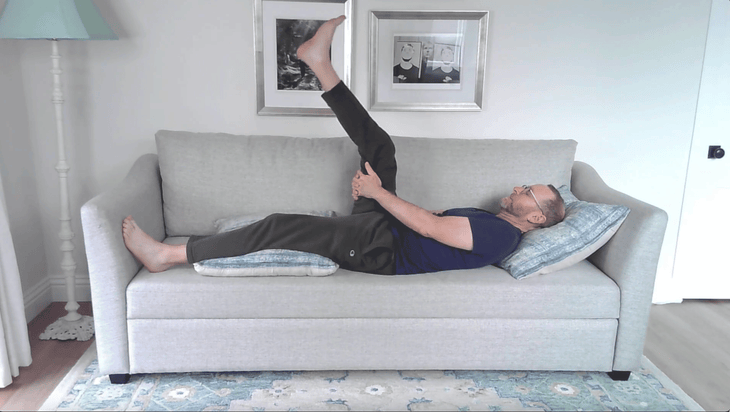
Reclined Kicks
Let’s lie down on the couch. I’m going to take away this mat beneath me and move the cushions a little so I can get more comfortable. You can take the other couch cushions away if you want more space. I’m using one pillow or cushion under my knees, and one under my head.
Take a breath here. Notice how you’re feeling. Start by hugging your right knee toward your chest as you hold the back of your thigh or shin. Give it a nice squeeze, even a little rock from side to side to open your right hip a little. Then take your hands to the back of your thigh and inhale as you lift your foot and straighten your leg.
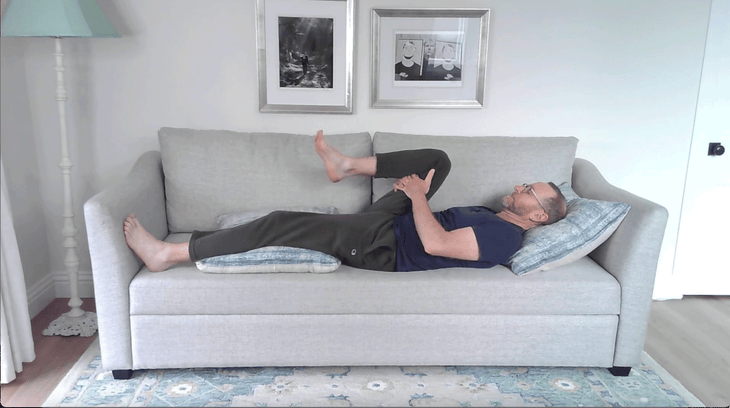
Exhale as you gently lower it back down. Inhale up, exhale, down. Do that a few more times. It’s an active movement rather than a passive stretch. One more time. Then release that side and repeat with the other leg.
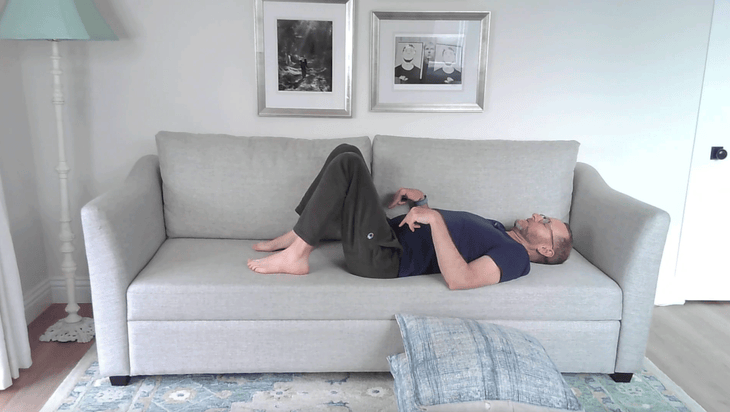
Reclined Pelvic Tilts and Bridge Pose
Take away the pillows underneath you. Bend your knees and bring your feet just underneath your knees, close in toward your buttocks. We’ll do some pelvic tilts to start. So press your tailbone down into the couch and inhale there.
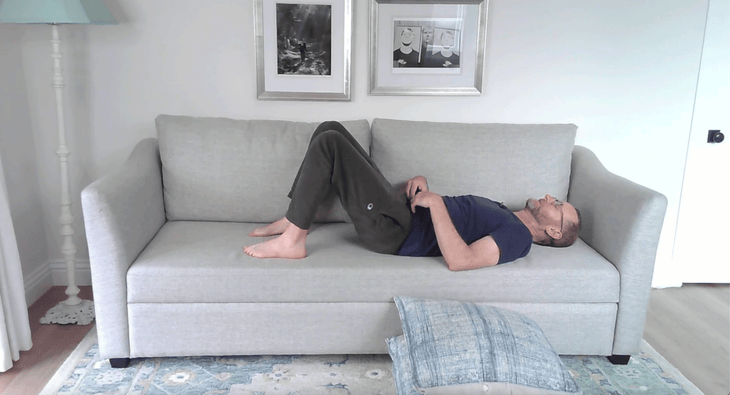
Then exhale as you press your lower back down and lift your tailbone. Exhale there and repeat. So inhaling tailbone down, exhaling lower back down. Inhale tailbone down, exhale lower back down.

The next time your lower back lifts, press into your feet and lift your hips up a little more in Bridge Pose if it feels comfortable in your body and your couch is firm. You’re not going to come too high and make sure you’re not shifting your weight all the way up onto your neck. Then lower back down. Inhale, lift a little and then lower back down. You don’t want to come very high because you’re on a soft couch. Do that a few more times then hug both knees into your chest and rock gently. You can also try crossing your ankles here as you rock. Notice how that feels. It’ll stretch a little more on the outside of your hips. Then cross your ankles the other way.
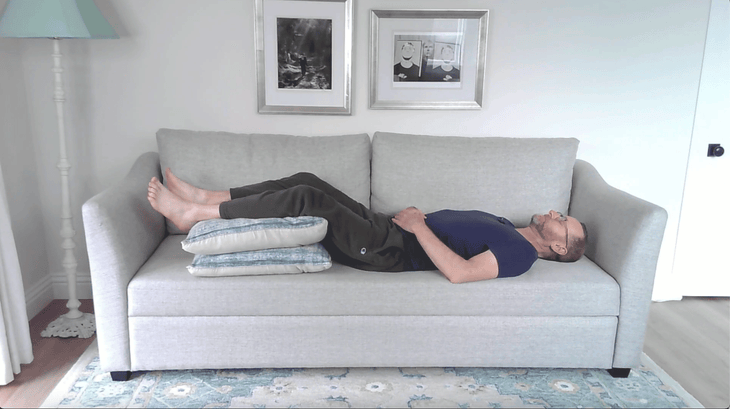
Reclined Inversion
Take your pillows or smaller couch cushions and stack them beneath your lower legs. The idea is you’re going to lie back on the couch and have some cushions beneath your lower legs so they’re slightly higher than the rest of your body. It’s a gentle variation of Legs up the Wall or legs up a chair. If you feel there’s too much pressure in your head, you can put a folded blanket or small pillow behind your head. Spend a minute resting here.
Inversions, even when this gentle, help to drain venous blood, that’s the blood that has more carbon dioxide in it, back toward your heart. They also help circulate the lymph fluid in your immune system back toward your chest so it can be recirculated.
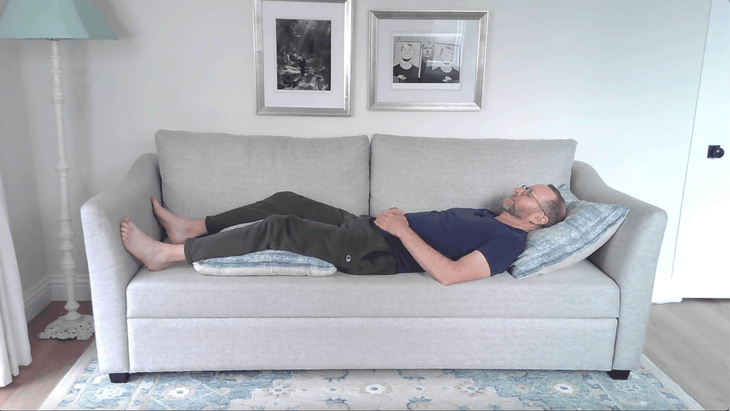
Savasana
You can stay here or, if you like, you can take the pillows away in a more traditional Savasana. Or perhaps you come back to how we had it before where there’s one pillow underneath your knees and a folded blanket or a small pillow underneath your head.
I’d like to start by stretching, tensing, and releasing each part of the body, as we do in Yoga Nidra. Start with your right leg and lift it just a little, tense the muscles, inhale, squeeze it tight all the way down to the foot, and then exhale as you release it to the couch. Repeat on your left leg, inhaling and tensing the muscles in the leg and exhaling as you lower and release.
Then stretch out your right arm as you inhale and spread your fingers apart. Make a fist and squeeze it tight before you exhale and release. Repeat on your left arm.
Inhale and squeeze your buttocks tight before you exhale and release. Inhale and expand your breath into your belly and chest and then open your mouth and exhale slowly. Squeeze your shoulders up to your ears and then slide your shoulders away from your ears, rock your head gently from side to side, and center your head. Inhale and squeeze your entire face and then exhale and release. Do that again, maybe making a face or sticking out your tongue or moving your jaw and stretching your face any way you like, and then exhale and release.
Make your body comfortable, including any adjustments that you need, maybe covering yourself with a blanket if you’re slightly cold. Scan your body with your mind, with a kind or neutral awareness, noticing any sensations. Simply notice, without judging, how you feel, starting with your feet, legs, hips and buttocks, pelvis and abdomen, and then into your chest, hands and arms and shoulders. Become aware of your entire back body, your whole spine, lower back, middle back and upper back, neck and throat, jaw, chin, mouth, and tongue. Also your cheeks and nose, eyes and forehead, your entire head, all the way up to the top. Bring a neutral awareness to your entire body, watching yourself resting, comfortable and relaxed.
Then, if you like, you can be aware of your breath, noticing how it moves on its own. And bring that same awareness to the mind itself, noticing if there are any thoughts that you can let go of and observe, like passing clouds. Notice how, just like clouds, when they do pass, the sun shines through. That’s the true self that’s always there in our heart. That’s one of the main practices of yoga, if not the definition of yoga. Quieting the mind to experience that peace that’s always there, the peace of the true self.
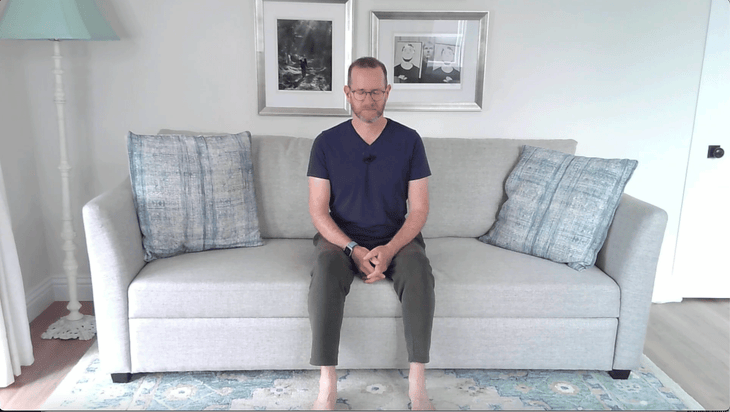
Seated Meditation
When you’re ready, take a deep inhalation and long exhalation. Take a few breaths that way and begin to wake your body, stretching out a little, starting with your fingers and your toes and continuing to stretch your body any way you like. Then roll to your side, resting here for a moment before you make your way up to seated. Pause here for a few minutes with some pranayama (breathwork) and meditation.
End your couch yoga practice by bringing your palms together at your chest. See if you can dedicate some of the positive feelings you found to someone in your life or that you’re thinking of right now. Bring that person to your mind, and as you bow to yourself, you can feel that you’re sending them some of that positive energy, or peace. We can end by saying Om, peace, peace, peace in Sanskrit, Om shanti, shanti, Shanti.
Join a special Couch Yoga Fundraiser live online donation class to support those affected by the fires in Los Angeles on Thursday, January 16, 2025, from 12:00-1:00pm PT. For more information and to register, click here.
To learn more about sharing yoga with the older adults in your life, join Jivana Heyman and special guests for a live online Accessible Yoga for Older Adults course.

